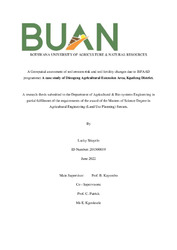| dc.description.abstract | This study was conducted in Dinogeng Agricultural Extension Area (DAEA) in the Kgatleng District located in the eastern part of Botswana. The main objective of this study was to assess the impacts of the Integrated Support Programme for Arable Agricultural Development (ISPAAD) programme on the environment using geospatial techniques. The study determined land use land cover changes (LULCC) using Geographical Information System (GIS) and Remote Sensing (RS), analysed soil fertility changes and mapped out soil erosion risk areas using Soil Loss Estimation Model for Southern Africa (SLEMSA) and GIS. Landsat 5 and 8 satellite images of 2006 and 2020 were obtained for the purpose of land cover classification. In a 14-year span (2006-2020), land use land cover (LULC) of DAEA changed markedly. Cultivated land and bare areas increased by 19.4 and 18.3 % whereas shrub land and forest areas decreased by 36.9 and 0.7 %, respectively. It is evident that the ISPAAD programme contributed to land degradation during the period. The chemical properties of the soils for eighteen farmers in Dinogeng were compared with data obtained from national soil map of Botswana (1988) scale 1: 250 000. The results showed an average decline of 1.55 for soil reaction (pH), 0.16 % for organic carbon (OC) and 6.75 Cmol/kg for cation exchange capacity (CEC). The rate of soil loss was determined by utilizing information on rainfall energy (E) using interpolation of rainfall data, topography using Digital Elevation Model (DEM), soil erodibility (F) using soil map and LULC data using satellite images within the SLEMSA framework. The results indicated that 88% of DAEA has low to moderate soil erosion risk (0 – 2 tha-1 yr-1 ). Only 12% of the study area experience very high to extreme high erosion risk (5 - ≥10 tha-1 yr-1 ) along the streams, at steep slopes and areas of bare land. It is a common practice for conservation measures to be applied on areas with high soil loss. Furthermore, the findings from this study may be useful to guide the development of functional soil conservation and land use planning as well as soil fertility management plan for Dinogeng Agricultural Extension Area. | en_US |

